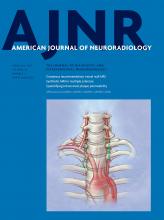Malhotra and colleagues have brought up a number of interesting questions regarding our recently published article on the neurovascular manifestations of hereditary hemorrhagic telangiectasia (HHT).1 A number of the questions raised by the authors would require completely new studies; however, we will do our best to answer their questions in general terms.
Regarding the use of screening MR imaging for patients with HHT, a vast majority of the patients included in our study received brain MRIs as part of a standard screening protocol. As an HHT Center of Excellence, our preference is to adhere to the international guidelines for diagnosis and management of HHT.2 We fully understand that there is no level 1 evidence to support the use of screening; however, screening is part of the standard of care for management of these patients.
A total of 23 patients with HHT who presented with ruptured or unruptured AVMs underwent treatment of their AVMs during this time period. A vast majority of these patients had surgery or radiosurgery. In general, outcomes related to treatment of these lesions were good, with low complication rates and no rehemorrhage. We recently published a study on the natural history of capillary vascular malformations and reported that the risk of hemorrhage from these lesions is zero.3 It is likely that the inclusion of capillary vascular malformations in natural history studies of brain AVMs in HHT is responsible for the deceivingly benign natural history of these lesions compared with sporadic AVMs.4⇓–6
Regarding the utility of vascular imaging in this patient subset, we certainly do not advocate the use of screening with conventional cerebral angiography for AVM diagnosis. Although cerebral angiography is a very safe procedure at our institution, it would not be cost-effective. We advocate the use of cerebral angiography if there is an equivocal finding on MR imaging or in preparation for treatment of a known brain AVM. MRA and CTA are also useful as problem-solving tools; however, based on our experience, contrast-enhanced MR imaging is generally sufficient as a screening modality for clinically significant brain AVMs. The recent addition of SWI to our HHT brain MR imaging protocol has proved useful.
A number of patients included in our study received repeat imaging. However, this was not part of a screening protocol. In general, patients who received repeat imaging had a neurologic symptom that warranted further investigation. In general, studies have found no utility in the use of repeat screening for the presence of brain AVMs, even in children.7
Ultimately, Maholtra and colleagues are correct that there is no literature proving that screening or preemptive treatment of AVMs are effective strategies in HHT. It is unlikely that a definitive answer to this question will be borne from a single large institution's experience. This is a rare disease that remains poorly understood. Large, multi-institutional collaborations such as the Brain Vascular Malformation Consortium HHT Investigator Group will be needed to better answer these questions.
References
- © 2017 by American Journal of Neuroradiology












